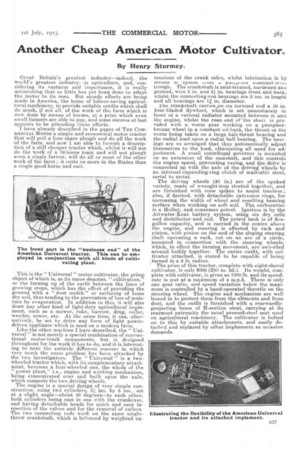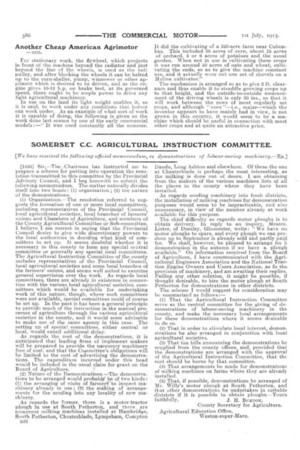Another Cheap American Motor Cultivator.
Page 31

Page 32

If you've noticed an error in this article please click here to report it so we can fix it.
By Henry Sturmey.
Great Britain's greatest industry—indeed, the -world's greatest industry—is agriculture, and, considering its vastness and importance, it is really astonishing that so little has yet been done to adapt the motor to its uses. But steady efforts are being made in America, the home of labour-saving agricultural machinery, to provide suitable outfits which shall do much, if not all, of the work of the farm which is now done by means of horses, at a price which even small farmers are able to pay, and some success at last appears to be attending these efforts. I have already described in the pages of THE COMMERCIAL MOTOR a simple and economical motor tractor that will pull a four-share plough and do all the work of the farm, and now I am able to furnish a description of a still cheaper tractor which, whilst it will not do the work of a 12-horse team and will not plough even a single furrow, will do all or most of the other work of the farm ; it costs no more in the states than a single good horse and cart.
This is the " Universal " motor cultivator, the primp object of which is, as its name denotes, "cultivation," or the turning up of the earth between the lines of growing crops, which has the effect of providing the ground with a " dust mulch" or surfacing of loose dry soil, thus tending to the prevention of loss of moisture by evaporation. In addition to this, it will also draw any other kind of light-duty agricultural implement, such as a mower, rake, harrow, drag, roller, weeder, sower, etc. At the same time it can, alternatively, be set to drive any form of light powerdriven appliance which is used on a modern farm.
Like the other machine I have described, the " Universal " is not merely a special combination of conventional motor-truck components, but is designed throughout for the work it has to do, and it is interesting to note the entirely different manner in which very much the same problem has been attacked by the two investigators. The " Universal " is a twowheeled tractor which, with its complementary attachment, becomes a four-wheeled one, the whole of the "power plant," i.e., engine and working mechanism, being concentrated over and built upon the axle, which connects the two driving wheels. The engine is a special design of very simple construction, using two cylinders, 3:'3 ins. by 5 ins., set at a slight angle—about 40 degrees—to each other, both cylinders being cast in one with the crankcase, and having detachable heads for quick and easy inspection of the valves and for the removal of carbon The two connecting rods work on the same singlethrow crankshaft, which is balanced by weighted ex
tensions of the crank sides, whilst lubrication is by
means ot spiasn limn a pulnn-reu constant-le vt.. trough. The crankshaft is heat-tleated, hardenect and
ground, with 5 in. and qin. bearings front and back, whilst the connecting-rod bearings are 3 ins, in length and all bearings are 1 in. diameter.
The crankshaft carries on ats forward end a 16 in. four-bladed flywheel, which is set immediately in front of a vertical radiator mounted between it and the engine, whilst the rea.nend of the shall is provided with a worm gear working on a phosphor
bronze wheel in a constant oil-bath, the thrust of the worm being taken on a large balt-thrust bearing and the radial load upon a radial ball bearing. The bear ings are so arranged that they automatically adjust themselves to the load, eliminating all need for adjustment. A small centrifugal governor is mounted on an extension of the camshaft, and this controls the engine speed, preventing racing, and the drive is connected up with the axle of the driving wheels by an internal-expanding-ring clutch of malla.able steel, metal to metal.
The driving wheels (40 in.) are of the spoked variety, made of wrought-iron riveted together, and are furnished with cone spikes to assist traction ; also, if desired, with detachable extension rings, for increasing the width of wheel and resulting bearing surface when working on soft soil. The carburetter is a Holley, and consumes petrol. Ignition is by the Attwater-Kent battery system, using six dry cells and distributor .and coil. The petrol tank is of five gallon capacity, and is carried in the centre above the engine, and steering is effected by rack and pinion, with pinion on the end of the sloping steering shaft operating a rack, cut on an arc of a circle, mounted in connectionwith the steering wheels, which, to effect the turning movement, are swivelled around bodily together. The entire outfit, with cultivator attached, is stated to be capable of being . turned in a 6 ft. radius.
• The price of this tractor, complete with eight-shovel cultivator, is only $385 (30 4s. 2d.). Its weight, complete with cultivator, is given as 1000 lb. and its speedrate is put at a maximum of 4 m.p.h. There is only one gear ratio, and speed variation below the maximum is controlled by a hand-operated throttle on the steering wheel. The engine and mechanism are well boxed in to protect them from the elements and from dust, and the outfit is furnished with a rearwardlyprojecting beam of H-section steel, carrying at its rearmost extremity the usual pressed-steel seat used on agricultural machinery. The cultivator is bolted on to this by suitable attachments, and easily detached and replaced by other implements as occasion demands.
For stationary work, the flywheel, which projects in front of the machine beyond the radiator and just beyond the line of the wheels, is used as the belt pulley, and after blocking the wheels it can be belted up to the corn-sheller, pump, winnower or other appliance which is desired to be driven, and as the engine gives 10-12 h.p. on brake test, at its governed speed, there ought to be ample power to drive any light agricultural machinery.
In use on the land its light weight enables it, so it is said, to work under any conditions that horses can work under. AS an example of what sort of work it is capable of doing, the following is given as the work done last season by one of the early commercial models :—" It was used constantly all the summer. It did the cultivating of a 220-acre farm near Columbus. This included 35 acres rif corn, about 15 acres of orchard, 5 or 6 acres of potatoes and the usual garden. When not in use in cultivating these crops it was run around 40 acres of oats and wheat, cultivating the. ends, so as to give the machine constant use, and it actually wore out one set of shovels on a Moline cultivator," The mechanism is arranged so as to give 2 ft. clearance and thus enable it to straddle growing crops up to that height, and the outside-to-outside measurement of the, driving wheels is only 30 ins., so that it will work between the rows of most regularly set crops, and although " corn "—i.e., maize—which the inventor appears to have mainly had in view, is not grown in this country, it would seem to be a machine which should be useful in connection with most other crops and at quite an attractive price.


































